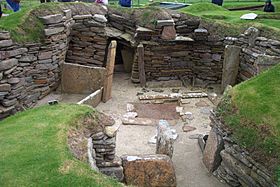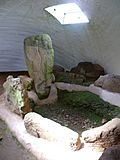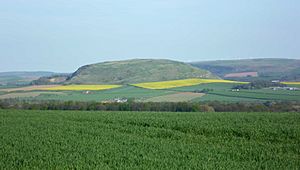Prehistoric Scotland facts for kids
Archaeology and geology help us discover the secrets of prehistoric Scotland. This is the time before the Romans arrived and started writing down history. Many human cultures spread across Europe, but focusing on Scotland helps us understand the ancient remains and monuments found there.
Scotland has many old sites that are easy to see. This is because much of the countryside is untouched by modern farming. Also, ancient people often used stone for building instead of wood, which lasts longer.
Contents
Scotland's Ancient Land: A Journey Through Time
Scotland's land is quite unique compared to the rest of Europe. It was once a piece of an ancient continent called Laurentia, which later became most of North America. Long, long ago, during the Cambrian period, the land that would become Scotland was part of Laurentia's coast, south of the equator.
Laurentia slowly moved towards another continent called Baltica (which became Scandinavia). They were separated by a big ocean called the Iapetus Ocean. Over millions of years, these continents crashed together. This huge impact created massive mountain ranges in Scotland, as tall as today's Alps! This also formed the West Highland and Grampian mountain chains.
Later, the Atlantic Ocean began to open up, separating Scotland from Laurentia. This caused more volcanic activity, especially on Scotland's west coast. This created new mountains on islands like Skye and Mull.
All this movement shaped Scotland's landscape. It created old mountains in the north and south, with a wide, fertile valley in between. The west became wilder with newer mountains. Later, during the Ice Ages, huge sheets of ice carved the land even more. They shaped river valleys into U-shapes and left behind rich, fertile soil in the lowlands.
Before Modern Humans Arrived
During a warm period between Ice Ages, about 130,000 to 70,000 BC, the climate in Europe was warmer than today. Even Neanderthals lived in parts of Europe. While Neanderthal sites have been found in southern England, we haven't found any traces of them in Scotland.
Later, glaciers covered most of Britain. It was only after the ice melted, about 15,000 years ago, that Scotland became a place where humans could live again.
Hunter-Gatherers: Life on the Move
As the climate got warmer, mesolithic hunter-gatherers began to explore Scotland. The oldest evidence we have is flint tools found at Howburn Farm in 2005. These tools date back to around 12,000 BC. This shows that people were in Scotland even during brief cold spells.
An early settlement at Cramond, near modern-day Edinburgh, dates back to about 8500 BC. Pits and holes suggest it was a hunter-gatherer camp. Stone tools found here are older than similar tools found in England. Even though no bones survived, burnt hazelnut shells show they cooked food. This suggests that hunter-gatherers might have settled down in Scotland, similar to other sites in Britain.
Other sites along the east coast, lochs, and rivers, along with many rock shelters and shell middens (ancient rubbish dumps) on the west coast, paint a picture of people who moved around a lot. They often used sites at different times of the year. They also used boats for fishing and to transport stone tools. Finds of flint tools in the mountains show these people could travel far inland.
At a rock shelter in Sand, Applecross, people lived around 7500 BC. They used tools made of bone, stone, and antlers. They ate shellfish, fish, and deer, cooking with "pot-boiler" stones. They also made beads from seashells and used colorful pigments.
Farmers and Monument Builders: Settling Down
The arrival of Neolithic farming brought permanent settlements to Scotland. At Balbridie in Aberdeenshire, archaeologists found traces of a huge timber-framed building from about 3600 BC. A very similar building was found near Stirling. On an island called Eilean Domhnuill in North Uist, pottery suggests that one of the earliest crannogs (island settlements) existed around 3200-2800 BC.
Many amazing Neolithic sites are found in the Orkney Islands. The local stone there splits easily into building slabs, which helped preserve these ancient places. Many other sites across Scotland are cared for by Historic Scotland.
At the well-preserved stone house called Knap of Howar on the Orkney island of Papa Westray, people lived from 3500 BC to 3100 BC. The walls are still standing, and the stone furniture is still inside! Evidence from their rubbish heaps shows they raised cattle, sheep, and pigs. They also farmed barley and wheat, gathered shellfish, and fished from boats. Their pottery connects them to nearby tombs and other sites far away.
The houses at Skara Brae on the Mainland of the Orkney Islands are very similar. They form a village connected by low passages. This village was used from about 3000 BC to 2500 BC. The pottery found here is similar to pottery found across Britain.
About 10 kilometers from Skara Brae are the Stones of Stenness, which were originally a stone circle. Nearby is Maeshowe, a beautiful passage grave (a type of ancient burial chamber) built before 2700 BC. Across a bridge is the Ring of Brodgar, another circle of standing stones. Scientists believe these stones were used as ancient observatories to study the stars. Another Neolithic village was found nearby, suggesting these farming people built and used these mysterious structures.
These monuments, like the Callanish stones on Lewis, are part of a larger Megalithic culture found across Europe. This culture also built Stonehenge in England and the stone rows at Carnac in France. People from this time also brought offerings from places like Cumbria and Wales to sacred sites like Cairnpapple Hill in West Lothian as early as 3500 BC.
Bronze Age: New Materials and Forts
During the Bronze Age, people started using metals like bronze. However, stone tools were still important. Around 2500 BC, there was less building of huge new monuments and less farming land used.
The Clava cairns and standing stones near Inverness show complex designs and are lined up with the stars. These tombs were smaller, perhaps for individuals, unlike the larger communal tombs of the Stone Age.
Ancient mummies from 1600-1300 BC were found at Cladh Hallan on South Uist.
Hill forts became common, like Eildon Hill near Melrose. This fort dates back to around 1000 BC and could hold hundreds of houses on a fortified hilltop. Evidence from Edinburgh Castle shows that people lived there around 850 BC during the late Bronze Age.
Iron Age: Forts and Kingdoms
From about 700 BC, and continuing into Roman times, the Iron Age was a time of many forts and protected farms. This suggests that different tribes and small kingdoms often argued or fought. Sometimes, people didn't keep their defenses strong, which might mean the forts were also symbols of power, not just for fighting.
Brythonic (or "Pritennic") Celtic culture and language spread into southern Scotland after the 8th century BC. This probably happened through people sharing ideas, not just invasions. Systems of kingdoms began to form.
Larger fortified settlements grew, like the Votadini stronghold of Traprain Law in East Lothian, which was as big as a town. Many smaller forts, called duns, hill forts, and ring forts, were built on any suitable hill or cliff. The amazing brochs were also built, with the nearly complete broch at Mousa on Shetland being a great example. Many Souterrains, which are underground passages, were also built, but their exact purpose is still a mystery. Island settlements connected to land by a causeway, called crannogs, also became common and were likely used for defense.
Exploring Ancient Scotland
The government website, Historic Scotland, lists many ancient sites and monuments you can visit, including most of those mentioned here. Many others are also free to explore. With a guide book and map, anyone can discover Scotland's distant past!
See also
 In Spanish: Prehistoria en Escocia para niños
In Spanish: Prehistoria en Escocia para niños




